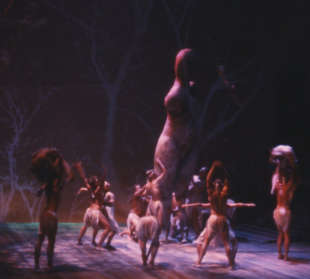Speight’s Wagner Memories: 84 TANNHÄUSER
Tannhäuser was a huge success and marked the first use of supertitles at Seattle Opera. After three minutes or so of confusion, the audience, like all audiences everywhere, took to the titles and loved them. It was also the only time I have ever had the same designer and director in a Wagner opera, not, I now believe, a good idea. It’s simply too much for any one person optimally to accomplish.
Two events stand out in this production. One was the controversy over the statue in the Venusberg. Robert Darling, who designed and directed the production, had duplicated a prehistoric statue of a woman representing Venus and hung it over the pink den of the goddess. For reasons I have never understood, all the women staff members at the Opera, and the few female board members present at early stage rehearsals, violently objected to the statue, seeing it as demeaning to women. I couldn’t see it then, and I still can’t figure it out. The designer of course couldn’t take out the statue as he had very little else onstage, and so I worked out a solution where the statue was barely lit. No critics or audience members had a thing to say about her.
More problematic was the rehearsal process. Seattle Opera was not at that time ready to prepare this kind of a huge show, and Darling, who was basically a designer, was not given appropriate time to direct the work. All this came down to two totally horrifying events: we were forced to work on the day before opening at a staggering labor cost (it is a contractually mandated free day), and Darling was working on his staging until the bitter end. He literally restaged the women in the Venus scene immediately before the overture began. Neither event has ever happened since.
On the positive side, there was the lovely look of the Hall of Song, and particularly the sheer silk curtain through which Elisabeth, a radiant Karen Bureau, appeared, singing an exciting “Dich, teure Halle.” The whole scene in the Hall of Song was wonderful to see: the chorus was dressed in colorful costumes, and the set was a glistening white. The magical, autumnal look of the final scene and Dale Duesing, the Wolfram, singing the Hymn to the Evening Star, the first of his many fine appearances at Seattle Opera, were of equal note. I also remember a critic writing something to the effect that he didn’t know where the Opera had found all the new money it had put into this production, but he was glad we had. I wasn’t so sure I knew either, but I knew that we had to change our image. This Tannhäuser certainly helped in that regard.
Two events stand out in this production. One was the controversy over the statue in the Venusberg. Robert Darling, who designed and directed the production, had duplicated a prehistoric statue of a woman representing Venus and hung it over the pink den of the goddess. For reasons I have never understood, all the women staff members at the Opera, and the few female board members present at early stage rehearsals, violently objected to the statue, seeing it as demeaning to women. I couldn’t see it then, and I still can’t figure it out. The designer of course couldn’t take out the statue as he had very little else onstage, and so I worked out a solution where the statue was barely lit. No critics or audience members had a thing to say about her.
More problematic was the rehearsal process. Seattle Opera was not at that time ready to prepare this kind of a huge show, and Darling, who was basically a designer, was not given appropriate time to direct the work. All this came down to two totally horrifying events: we were forced to work on the day before opening at a staggering labor cost (it is a contractually mandated free day), and Darling was working on his staging until the bitter end. He literally restaged the women in the Venus scene immediately before the overture began. Neither event has ever happened since.
On the positive side, there was the lovely look of the Hall of Song, and particularly the sheer silk curtain through which Elisabeth, a radiant Karen Bureau, appeared, singing an exciting “Dich, teure Halle.” The whole scene in the Hall of Song was wonderful to see: the chorus was dressed in colorful costumes, and the set was a glistening white. The magical, autumnal look of the final scene and Dale Duesing, the Wolfram, singing the Hymn to the Evening Star, the first of his many fine appearances at Seattle Opera, were of equal note. I also remember a critic writing something to the effect that he didn’t know where the Opera had found all the new money it had put into this production, but he was glad we had. I wasn’t so sure I knew either, but I knew that we had to change our image. This Tannhäuser certainly helped in that regard.
